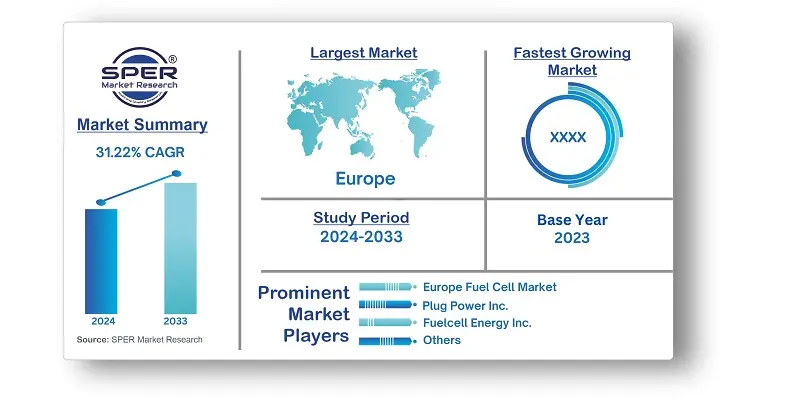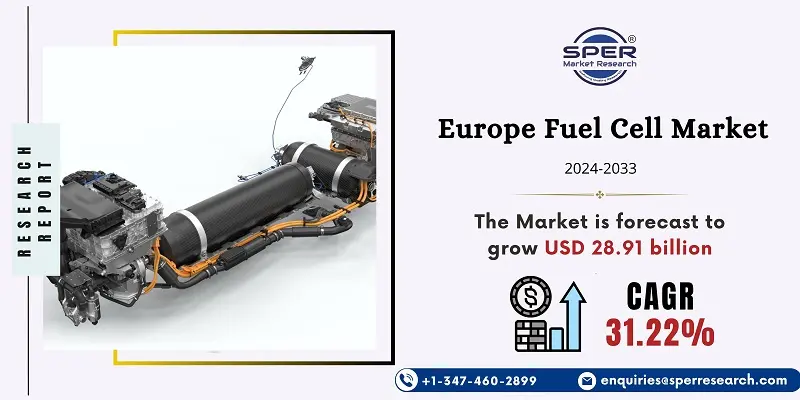
Europe Fuel Cell Market Growth, Trends, Share, Size, Revenue Demand and Future Outlook
Europe Fuel Cell Market Size- By Application, By Technology, By End User, - Regional Outlook, Competitive Strategies and Segment Forecast to 2033
| Published: Aug-2024 | Report ID: POAE2470 | Pages: 1 - 155 | Formats*: |
| Category : Power & Energy | |||
- July 2022; In order to assist research, innovation, and the initial industrial development in the hydrogen technology value chain, fifteen Member States collectively prepared and notified the European Commission, which granted USD 5.47 billion in public funding for the IPCEI Hy2Tech project. It was anticipated that hydrogen would emerge as a top power generation alternative and propel the fuel cell industry.
- February 2022; A novel fuel cell system for long-haul vehicles is being developed by Ballard Power Systems and the MAHLE group. At Ballard's hydrogen test facility in Stuttgart, Germany, MAHLE Group, an automobile supplier, was contracted to accept the first delivery of a 120kW fuel cell module. It was anticipated that the corporation would produce up to 360kW of power.


| Report Metric | Details |
| Market size available for years | 2020-2033 |
| Base year considered | 2023 |
| Forecast period | 2024-2033 |
| Segments covered | By Application, By Technology, By End-User |
| Regions covered | Northern, Central, Western, Eastern, Southern |
| Companies Covered | Ballard Power System Inc., Bloom Energy Corporation, Ceres Power Holdings plc, Elcogen AS, Fuelcell Energy Inc., Hydrogenics Corporation, ITM Power plc, Nuvera Fuel Cells LLC, Plug Power Inc., and Toshiba Corp. |
- Automotive Manufacturers
- Energy Companies
- Government Agencies and Regulatory Bodies
- Research Institutions and Academia
- Industrial and Commercial Users
| By Application: |
|
| By Technology: |
|
| By End-Users: |
|
- Europe Fuel Cell Market Size (FY'2024-FY'2033)
- Overview of Europe Fuel Cell Market
- Segmentation of Europe Fuel Cell Market by Application (Portable, Stationary, Transportation)
- Segmentation of Europe Fuel Cell Market by Technology (Polymer Electrolyte Membrane Fuel Cell, Solid Oxide Fuel Cell, Others)
- Segmentation of Europe Fuel Cell Market by End-User (Residential, C&I, Transportation, Data Center, Military and Defence)
- Statistical Snap of Europe Fuel Cell Market
- Expansion Analysis of Europe Fuel Cell Market
- Problems and Obstacles in Europe Fuel Cell Market
- Competitive Landscape in the Europe Fuel Cell Market
- Impact of COVID-19 and Demonetization on Europe Fuel Cell Market
- Details on Current Investment in Europe Fuel Cell Market
- Competitive Analysis of Europe Fuel Cell Market
- Prominent Players in the Europe Fuel Cell Market
- SWOT Analysis of Europe Fuel Cell Market
- Europe Fuel Cell Market Future Outlook and Projections (FY'2024-FY'2033)
- Recommendations from Analyst
1.1. Scope of the report1.2. Market segment analysis
2.1. Research data source
2.1.1. Secondary Data2.1.2. Primary Data2.1.3. SPER’s internal database2.1.4. Premium insight from KOL’s
2.2. Market size estimation
2.2.1. Top-down and Bottom-up approach
2.3. Data triangulation
4.1. Driver, Restraint, Opportunity and Challenges analysis
4.1.1. Drivers4.1.2. Restraints4.1.3. Opportunities4.1.4. Challenges
4.2. COVID-19 Impacts of the Europe Fuel Cell Market.
5.1. SWOT Analysis
5.1.1. Strengths5.1.2. Weaknesses5.1.3. Opportunities5.1.4. Threats
5.2. PESTEL Analysis
5.2.1. Political Landscape5.2.2. Economic Landscape5.2.3. Social Landscape5.2.4. Technological Landscape5.2.5. Environmental Landscape5.2.6. Legal Landscape
5.3. PORTER’s Five Forces
5.3.1. Bargaining power of suppliers5.3.2. Bargaining power of buyers5.3.3. Threat of Substitute5.3.4. Threat of new entrant5.3.5. Competitive rivalry
5.4. Heat Map Analysis
6.1. Europe Fuel Cell Market Manufacturing Base Distribution, Sales Area, Product Type6.2. Mergers & Acquisitions, Partnerships, Product Launch, and Collaboration in Europe Fuel Cell Market
7.1. Europe Fuel Cell Market Size, Share and Forecast, By Application, 2020-20267.2. Europe Fuel Cell Market Size, Share and Forecast, By Application, 2027-20337.3. Portable7.4. Stationary7.5. Transportation
8.1. Europe Fuel Cell Market Size, Share and Forecast, By Technology, 2020-20268.2. Europe Fuel Cell Market Size, Share and Forecast, By Technology, 2027-20338.3. Polymer Electrolyte Membrane Fuel Cell8.4. Solid Oxide Fuel Cell8.5. Others
9.1. Europe Fuel Cell Market Size, Share and Forecast, By End-Users, 2020-20269.2. Europe Fuel Cell Market Size, Share and Forecast, By End-Users, 2027-20339.3. Residential9.4. C&I9.5. Transportation9.6. Data Center9.7. Military and Defence
10.1. Europe Fuel Cell Market Size and Market Share
11.1. Europe Fuel Cell Market Size and Market Share By Region (2020-2026)11.2. Europe Fuel Cell Market Size and Market Share By Region (2027-2033)11.3. Central Europe11.4. Eastern Europe11.5. Northern Europe11.6. Western Europe
12.1. BALLARD POWER SYSTEM INC.
12.1.1. Company details12.1.2. Financial outlook12.1.3. Product summary12.1.4. Recent developments
12.2. BLOOM ENERGY CORPORATION
12.2.1. Company details12.2.2. Financial outlook12.2.3. Product summary12.2.4. Recent developments
12.3. CERES POWER HOLDINGS PLC
12.3.1. Company details12.3.2. Financial outlook12.3.3. Product summary12.3.4. Recent developments
12.4. ELCOGEN AS
12.4.1. Company details12.4.2. Financial outlook12.4.3. Product summary12.4.4. Recent developments
12.5. FUELCELL ENERGY INC.
12.5.1. Company details12.5.2. Financial outlook12.5.3. Product summary12.5.4. Recent developments
12.6. HYDROGENICS CORPORATION
12.6.1. Company details12.6.2. Financial outlook12.6.3. Product summary12.6.4. Recent developments
12.7. ITM POWER PLC
12.7.1. Company details12.7.2. Financial outlook12.7.3. Product summary12.7.4. Recent developments
12.8. NUVERA FUEL CELLS LLC
12.8.1. Company details12.8.2. Financial outlook12.8.3. Product summary12.8.4. Recent developments
12.9. PLUG POWER INC.
12.9.1. Company details12.9.2. Financial outlook12.9.3. Product summary12.9.4. Recent developments
12.10. TOSHIBA CORP.
12.10.1. Company details12.10.2. Financial outlook12.10.3. Product summary12.10.4. Recent developments
12.11. Others
SPER Market Research’s methodology uses great emphasis on primary research to ensure that the market intelligence insights are up to date, reliable and accurate. Primary interviews are done with players involved in each phase of a supply chain to analyze the market forecasting. The secondary research method is used to help you fully understand how the future markets and the spending patterns look likes.
The report is based on in-depth qualitative and quantitative analysis of the Product Market. The quantitative analysis involves the application of various projection and sampling techniques. The qualitative analysis involves primary interviews, surveys, and vendor briefings. The data gathered as a result of these processes are validated through experts opinion. Our research methodology entails an ideal mixture of primary and secondary initiatives.



Frequently Asked Questions About This Report
PLACE AN ORDER
Year End Discount
Sample Report
Pre-Purchase Inquiry
NEED CUSTOMIZATION?
Request CustomizationCALL OR EMAIL US
100% Secure Payment






Related Reports
Our Global Clients
Our data-driven insights have influenced the strategy of 200+ reputed companies across the globe.




















